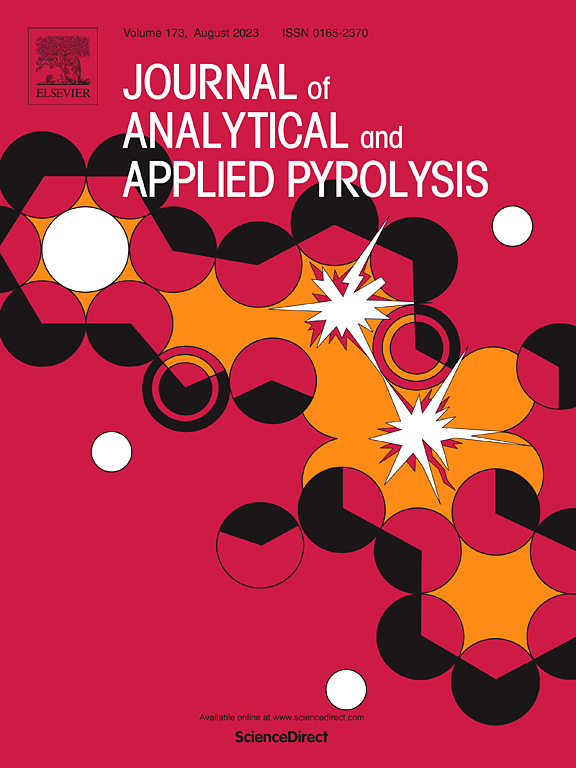Deciphering thermal-state structure and thermal strength structure-property relationships via "High-temperature quenching cross-state SEM analysis"
IF 6.2
2区 化学
Q1 CHEMISTRY, ANALYTICAL
引用次数: 0
Abstract
This study investigates the structural drivers of high-temperature compressive strength degradation in metallurgical coke during pyrolysis (25–1200 °C) through an integrated approach combining in-situ mechanical testing and multi-scale characterization. A novel in-situ high-temperature compression system coupled with liquid nitrogen quenching enabled real-time strength measurements and thermal-state structure preservation. XRD, TEM, and BET revealed dual-regime behavior: Below 1000 °C, compressive strength remained stable (28.03 ± 0.77 MPa) due to C-O crosslinking networks, while exceeding this threshold triggered irreversible strength loss (21.54 MPa at 1200 °C). Graphitization dominated structural evolution, evidenced by decreased (002) interlayer spacing (0.3860→0.3774 nm) and increased graphitic stacking height (Lc: 0.67→0.77 nm). Specific surface area surged 149 % (4.23→10.51 m²·g−1) above 1000 °C, with micropore volume growth indicating pore network reconstruction. XPS and FT-IR confirmed thermal cleavage of C-O bonds (25.36 %→9.84 %), destabilizing carbon matrices. Natural cooling leads to the collapse of the pore structure of coke and the fusion of pore walls, while the liquid nitrogen quenching process can clearly reveal the evolution law of pores. The deterioration mechanism links sp2 domain growth (7.74 %→65.41 %) to weakened interlayer cohesion and microcrack propagation. These findings establish a pyrolysis-structure-strength correlation model, providing actionable insights for designing coke with enhanced thermal stability in blast furnace operations.
通过“高温淬火跨态SEM分析”解读热态结构和热强度结构-性能关系
本研究通过现场力学测试和多尺度表征相结合的综合方法,研究了冶金焦在热解(25-1200℃)过程中高温抗压强度退化的结构驱动因素。一种新型的原位高温压缩系统与液氮淬火相结合,实现了实时强度测量和热态结构保存。XRD、TEM和BET显示了双态行为:在1000℃以下,由于C- o交联网络的存在,抗压强度保持稳定(28.03 ± 0.77 MPa),而超过这一阈值会导致不可逆强度损失(1200℃时21.54 MPa)。石墨化主导了结构演变,层间距(002)减小(0.3860→0.3774 nm),石墨层高度(Lc: 0.67→0.77 nm)增加。在1000℃以上,比表面积增加149 %(4.23→10.51 m²·g−1),微孔体积增大表明孔隙网络重构。XPS和FT-IR证实了C-O键的热裂解(25.36 %→9.84 %),破坏了碳基体的稳定。自然冷却导致焦炭孔隙结构坍塌,孔壁熔合,而液氮淬火过程可以清晰地揭示孔隙的演化规律。sp2畴生长(7.74 %→65.41 %)与层间黏聚力减弱和微裂纹扩展有关。这些发现建立了热解-结构-强度相关模型,为设计高炉操作中具有增强热稳定性的焦炭提供了可行的见解。
本文章由计算机程序翻译,如有差异,请以英文原文为准。
求助全文
约1分钟内获得全文
求助全文
来源期刊
CiteScore
9.10
自引率
11.70%
发文量
340
审稿时长
44 days
期刊介绍:
The Journal of Analytical and Applied Pyrolysis (JAAP) is devoted to the publication of papers dealing with innovative applications of pyrolysis processes, the characterization of products related to pyrolysis reactions, and investigations of reaction mechanism. To be considered by JAAP, a manuscript should present significant progress in these topics. The novelty must be satisfactorily argued in the cover letter. A manuscript with a cover letter to the editor not addressing the novelty is likely to be rejected without review.

 求助内容:
求助内容: 应助结果提醒方式:
应助结果提醒方式:


